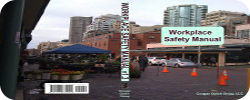The OSHA Small Business Handbook is a fifty-six page guide about bringing your small business into OSHA compliance. OSHA claims to be streamlining their program to meet the needs of small business and future business needs while eliminating red tape. The goal for OSHA and for all employers is, at the end of the day, to send all employees home – whole. To this end, OSHA has developed a four point program:
- Management Commitment And Employee Involvement
- Worksite Analysis
- Hazard Prevention And Control
- Training for Employees, Supervisors and Managers
Point number one almost goes without saying: without a commitment to safety, work practices will remain careless and injuries will happen. Experience tells us, people do not naturally look out for their own safety and the safety of others. However, I have seen the attitudes of management and employees change after a simple safety orientation training. So, if management is committed to safety and willing to expend the time and money necessary to instruct the employees in safety, the workers usually reciprocate by working toward a safe and productive working environment. This usually results in a net savings in direct and operating costs.
The point we want to cover in this session, however, is point number two: the worksite analysis. This is the nut – the beginning of every effective safety management system. Without it, you will be hard pressed to fully scope points three and four. In order to control hazards and train your employees successfully, you must first determine what hazards and potential risks exist and what is necessary to keep your employees safe.
Within the OSHA Small Business Handbook is a twenty-four page checklist for self-inspecting your place of business or worksite. Well that is simple: walk through the checklist, develop an accident prevention program and become OSHA compliant. Right? Not really.
There is a section of the OSH ACT OF 1970 called the General Duty Clause that says, “Each employer shall furnish to each of his employees employment and a place of employment which are free from recognized hazards that are causing or are likely to cause death or serious physical harm to his employees.” This means the OSHA Small Business Handbook Self-Inspection Checklist is only the starting point. Or, in other words, if your safety program meets the scope of the checklist, you still have not reached OSHA compliance.
For this reason, we have developed a checklist that is almost seventy pages. We try to discover every possible area where hazards may occur in your place of business. From this, we develop a safety management and accident prevention program to suit your working environment. We cover OSHA, EPA and ADA requirements to help reduce your liability and help assure a safe place to work for all your employees.
A walk-through with the checklist usually takes two to four hours for small businesses. The first thing we examine is your existing safety program as well as hazard identification and communication and record keeping for accidents and injuries. Then we walk through your business and/or work site, looking for potential hazards – whether they be chemicals, machinery or housekeeping endangerments. When the walk-through is complete, we will ask you a few questions to clarify our understanding of your business and then we go back to the office.
At the office, we review the checklist with our notes and we write up a report for you, explaining where you are deficient and what you need to do to come up to and exceed OSHA, EPA and ADA compliance. We itemize the pricing so you are able to select the most important sections and still meet your budget.
It is the goal of Cougar Gulch Group, LLC to keep you out of trouble and help keep your employees safe from harm. Call Dean today at 208-699-6877 to schedule your site analysis – the walk through and consultation is free (if your business is out-of-town or out-of-state, there will be a nominal travel fee).
OSH ACT OF 1970 [29 USC 654] SEC. 5. Duties (a) Each employer: (a)(1) shall furnish to each of his employees employment and a place of employment which are free from recognized hazards that are causing or are likely to cause death or serious physical harm to his employees; (2) shall comply with occupational safety and health standards promulgated under this Act. (b) Each employee shall comply with occupational safety and health standards and all rules, regulations, and orders issued pursuant to this Act which are applicable to his own actions and conduct.

